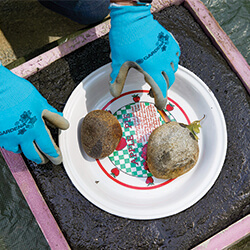Gardening: Invite the birds for a drink

 More online: Gardening to-do list, Gardening Q&A and Scents of the Season
More online: Gardening to-do list, Gardening Q&A and Scents of the Season

Looking for a weekend project? Make a birdbath! Photo: © 2021 Fred Greaves
Most mornings, I take my tea onto the back deck so I can watch the goldfinches playing in the birdbath. A family of young robins comes by to splash in the water and have a drink. I've also seen common house finches, rufous-sided towhees, doves and more.
My birdbath is homemade of hypertufa, which is a combination of Portland cement, sand and peat moss or vermiculite. Both work equally well. The idea is to have a finished product that is lighter than cement alone and that has a natural, rustic look.
Inspiration for the project came from an old gardening book in which the author likened making the birdbath to childhood days playing in the mud. His original plans called for a base and a pedestal, but most bird experts say birdbaths work best when placed near the ground.
Once you have all the materials together, the project takes less than two hours to complete. The birdbath requires an additional two to three weeks to cure and harden, but after that it will be open for business.
A wheelbarrow or 5-gallon bucket works best for mixing the ingredients. Wear rubber gloves when working with Portland cement—it can irritate your skin—and a dust mask to protect your nose and lungs.
Before we start, here's an easy alternative to making your own form for the birdbath: You can use a cardboard box or a plastic bin, and then a pie plate or something to make the impression for holding water. If you choose this route, go directly to step 3.

What you need:
2 (2x4-foot) pieces of 1-inch polystyrene insulation board
Tape measure or metal ruler
Jigsaw or sharp utility knife Sheetrock screws (optional)
Heavy-duty duct tape
Wheelbarrow
Hoe
1 bag Portland cement
1 bag finely textured sand
1 (2-cubic-foot) bag peat moss or vermiculite
Liquid or powder concrete dye (optional)
Vegetable oil or nonstick spray
Shallow bowl, no more than 2 inches deep
Plastic or tarp
Gloves
Dust mask
Stiff brush or metal file
Masonry sealer

Pattern for basin:
1 (15x15-inch) piece for base
4 (5x16-inch) pieces for sides
Hypertufa (I used a 1-pound coffee can for measurements):
3 parts Portland cement
3 parts sand
6 parts peat moss or vermiculite
What you do:
1. Using the measurements on the opposite page, mark the dimensions on the insulation board. Cut the forms using a jigsaw or utility knife. I used a knife and a metal ruler.

2. The pieces that form the sides of the basin wrap around the base piece. Use sheetrock screws to hold it together and wrap with heavy-duty duct tape. Set aside.
3. In the wheelbarrow, use a hoe to mix the hypertufa. Mix about a third of the ingredients at a time, until all have been added and mixed. Add concrete dye, then begin adding water slowly and continue mixing. Keep checking consistency as you add water. The mix should hold together when you squeeze a handful of it. It should not be soupy; it shouldn't be crumbly. Being a little on the wet side is better than being on the dry side.
4. Use vegetable oil or nonstick spray to coat the inside of the form for the birdbath.

5. Add the hypertufa mixture a little at a time and tamp it down so there are no air holes. Do not fill to the top; leave an inch or two.
6. Coat the bottom of a shallow bowl with vegetable oil and press it into the mixture, making sure it is snugly pushed into the hypertufa mixture. Add and tamp more of the hypertufa mix around the bowl until you have a smooth, even surface that's level with the top of the form. You might need to put a rock or brick on it to hold it down. Make sure there is plenty of hypertufa around the sides of the shallow bowl.
7. Cover it with a piece of plastic or a tarp, and leave it to cure for 48 hours. After 48 hours, you can carefully remove the forms, but the birdbath will need to continue to cure for several days or up to three
weeks, depending on the weather. Make sure it is in a
shady, protected spot. Gently sprinkle it with water
every day or two if the weather is dry and hot, less
often if the weather is cool. Leave it covered between
sprinklings.

8. Once the pieces are hard, use a stiff brush or file to smooth the edges. Finally, apply a coat of masonry sealer to the depression of the basin.
Tips:
Keep the water shallow, no deeper than 2 inches. Put rocks or pebbles in the water so the birds have good footing.
If there are cats or other predators in your neighborhood, you may need a birdbath on a pedestal or that you can hang from a tree so the birds can see the area around the birdbath where predators might hide.
Place the birdbath in a mostly shady location. Avoid areas with hot afternoon sun.
Make sure the water is always fresh. One of the spray emitters on my drip irrigation system refills the birdbath every day.
Keep it clean.

